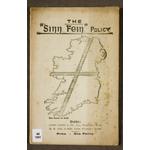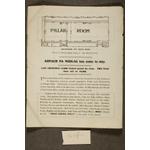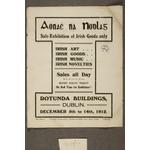Those that set the stage
Arthur Griffith and Sinn Féin
Griffith and Sinn Féin contributed directly to the Rising by his brilliant propaganda and by radicalising a generation of Irish nationalists.
Arthur Griffith (1871-1922) was born at 61 Upper Dominick Street, Dublin and was educated at the Christian Brothers’ schools at Strand Street and St Mary’s Place. He worked as a printer at the Irish Independent, spending much of his spare time in debating societies where he came under the influence of the journalist and poet William Rooney. In 1893 they founded the Celtic Literary Society which promoted the study of Irish language, literature, history and music, its political slogan being ‘independent action’. Griffith was also active in the Gaelic League in which Rooney was a teacher. He was a member of the separatist Irish Republican Brotherhood up until 1910, after which time he generally repudiated the use of physical force for political ends.
Following a period in South Africa where he worked in the gold mines and gave some assistance to the Boers, he became editor of the new weekly radical paper, the United Irishman, first published in Dublin in March 1899. In 1900, together with Rooney he established Cumann na nGaedheal, an umbrella body designed to co-ordinate the activities of the various groups endeavouring to counteract the continuing anglicisation of the country. After the failure of the Home Rule bills of 1886 and 1893, Griffith had little faith in the current mode of parliamentary action. In a series of articles, ‘The resurrection of Hungary: a parallel for Ireland’, published in the United Irishman in 1904, he proposed that the Irish Parliamentary Party withdraw from Westminster and unilaterally form a national assembly in Dublin taking the Hungarian experience as a role model.
A political organisation representing Griffith’s policy of national economic, cultural and political self-reliance evolved over the period 1905-7. It incorporated Cumann na nGaedheal and the Dungannon Clubs established by Bulmer Hobson and Denis McCullough. The name ‘Sinn Féin’ was suggested by Máire Butler as succinctly expressing the spirit of the movement. When the United Irishman closed in 1906 due to a libel action, Griffith adopted the title Sinn Féin for the replacement paper where he continued to promote his policies until its suppression in 1914.
Griffith found little favour with the Irish Parliamentary Party or, at the other extreme, with most of the physical force separatists, although the IRB subsidised his paper Sinn Féin. Griffith joined the Irish Volunteers on their foundation in November 1913, though he was not appointed to the executive lest the new organisation appear too closely associated with Sinn Féin. In July 1914 he was involved with the landing of arms for the Irish Volunteers at Howth. On 9 September that same year he attended a meeting, arranged seemingly under the auspices of the IRB and with Thomas Clarke presiding, to consider the opportunity for an insurrection provided by the war. Griffith, however, was not in favour of the use of physical force except as a last resort. He discouraged Irishmen from fighting with the British army in the war, as a result of which Sinn Féin was banned in December 1914; Griffith promptly replaced it with Scissors and Paste and later with Nationality, both of which continued to promote Sinn Féin policies.
Sinn Féin and the writings of Griffith played an important role in developing a spirit of national self reliance in the years leading up to the 1916 Rising. Indeed, the public profile of Sinn Féin was such that on the outbreak of the Rising the government and the public at large assumed that it was responsible, the Rising being generally referred to as ‘the Sinn Féin Rebellion’—the Irish Volunteers had generally been known as the ‘Sinn Féin Volunteers’. While some members of Sinn Féin took part in an individual capacity, neither the organisation nor Griffith himself was involved in the Rising. He did offer his services at the General Post Office, but was advised that he could do more with the pen than the gun. Nevertheless, he was arrested and imprisoned in Reading Jail until the following February.









